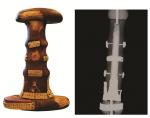Posts: 4,863
Threads: 129
Joined: Nov 2011
Reputation:
32
Photobucket sucks, and now they're charging people for 3rd party hosting because of the lapsing of net neutrality laws in America (where they're based out of).
Use imgur, open up the image and copy and paste the link into [IMG] tags. It's free
Posts: 1,073
Threads: 51
Joined: Aug 2011
Reputation:
82
10-05-2017, 08:41 AM
(This post was last modified: 10-05-2017, 09:12 AM by Crispianus.)
There are other chronologies then Miks (which I dont have yet though I've had it on order from the library for ages) the one I have is "
Illerup Adal, Die Schwerter" which I highly recommend and pretty much cover swords from Northern Europe, "
Osterburken-Kamathen" is there classified as "
Osterburken-Vrasselt" and includes 13 swords of which one is "Kamathen".
The text says there are only fragments of the organic components of grips and impossible to tell the form, however one example from Vrasselt had decorated boat shaped metal plates for the guard and pommel and there was at least some ivory involved, the suggestion there is that these are Nydam type grips.... none of this type exists at illerup.
Osterburken-Vrasselt plus sub type 13 swords total, from the above vol.

Nydam Swords from
Denmark in the early iron age

The Cumberland Hilt added here for its similarity to No4 from Nydam.

Source:
http://www.barbicanra.co.uk/assets/pd-ap...pology.pdf
Ivor
"And the four bare walls stand on the seashore. a wreck a skeleton a monument of that instability and vicissitude to which all things human are subject. Not a dwelling within sight, and the farm labourer, and curious traveller, are the only persons that ever visit the scene where once so many thousands were congregated." T.Lewin 1867
Posts: 4,863
Threads: 129
Joined: Nov 2011
Reputation:
32
Awesome post, thanks. Yeah as far as I can tell the Osterburken Grips generally fall under Germanic Type-I (Not sure if Cumberland falls under that, it's later) which the no.4 from Nydam and the hilt from Samsun both belong to.
Hexagonal/Octagonal grips seem to be a uniquely 5th century trend, I think? Not sure.
Posts: 4,863
Threads: 129
Joined: Nov 2011
Reputation:
32
I have a copy of the Miks book with me. Interestingly enough I can't find the Feltwell listed.
Pouan is an Osterburken-Kemathen blade, much as I suspected (p. 708-709).







